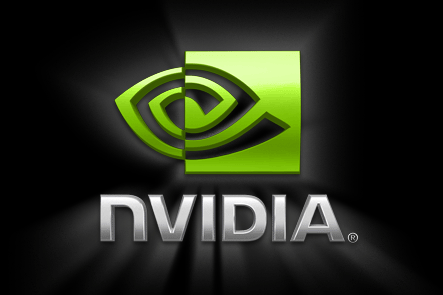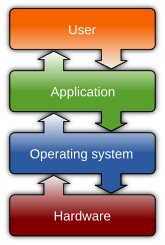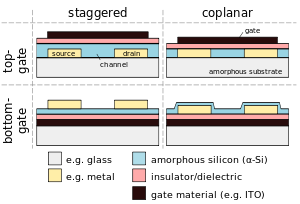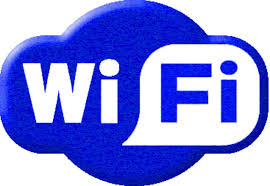| Term |
Expansion |
Explanation |
More Info Links |
NI FAQ Wiki
|
External |
NAND
|
NotAND Flash Memory

|
Toshiba announced NAND flash memory at the 1987 International Electron Devices Meeting. It has reduced erase and write times, and requires less chip area per cell, thus allowing greater storage density and lower cost per bit than NOR flash; it also has up to ten times the endurance of NOR flash.
• ADAM contains 1GB of SLC NAND memory, where the Android operating system, Eden user interface, and stock applications are installed.
|
2c – Memory and Storage
|
NAND
on Wikipedia
|
NFC
|
Near Field Communication

|
Near Field Communication is a short-range high frequency wireless communication technology which enables the exchange of data between devices over about a 10 centimeter distance.
• ADAM does not support NFC, as far as we know.
|
1h – Wish List
|
NFC
on Wikipedia
|
NI
|
Notion Ink

|
• Co-Founded by CEO Rohan Shravan, Notion Ink is the enterprise behind ADAM, EDEN, and Genesis.
|
1 – NOTION INK, COMPANY and COMMUNITY |
Notion Ink
website
|
nVidia
|
Nvidia Corporation

|
Nvidia is a multinational corporation from Santa Clara, California, USA, which specializes in the development of graphics processing units and chipset technologies for workstations, personal computers, and mobile devices.
• ADAM is powerered by an nVidia Tegra 250 system-on-a-chip processor.
|
2b – System-on-Chip |
nVidia
on Wikipedia
nVidia
global website
|
OS
|
Operating System
 |
An operating system is software, consisting of programs and data, that runs on a computer, managing computer hardware resources, and providing common services for efficient execution of various apps. Operating systems are found on almost any device that contains a computer—from cellular phones and video game consoles to supercomputers and web servers – and tablets like ADAM.
• ADAM ships with the Android OS, with a custom Eden user interface on top. Notion Ink initially announced the capability of running Android, Chrome OS and Ubuntu on ADAM. |
Which OS-es does ADAM support?
on 3a – All about Eden and Android
1f – OS Alternatives
|
Operating System
on Wikipedia
|
Panels
|
The Panels of Eden

|
• Panels (also known as Leaves) are a feature of ADAM's Eden user interface, and provide a visual metaphor for multitasking. A Panel is a "placeholder" for a light-weight feature-limited version of the application, when actually the application is sleeping. ADAM’s display shows three adjacent panels at a time, a sub-set of all the currently open panels (see diagram, left – click to enlarge).
|
3b – The Panels of Eden |
Week-End Special Part IV – The Eden!
on Rohan's NI Blog
|
POP
|
Post Office Protocol

|
The Post Office Protocol is an application-layer Internet standard protocol used by email client apps to retrieve email from a remote server. POP and IMAP (Internet Message Access Protocol) are the two most prevalent Internet standard protocols for email retrieval. Virtually all modern email clients and servers support both. The POP protocol has been developed through several versions, with version 3 (POP3) being the current standard.
• ADAM’s email app Mail’d supports SMTP, POP, and IMAP.
|
3c1 – Mail'd |
POP
on Wikipedia
|
PQ
|
Pixel Qi Corporation

|
Pixel Qi is an enterprise founded by Mary Lou Jepsen, who was involved in the development of low-power displays she invented originally for the OLPC (One Laptop Per Child) XO.
• One of ADAM's two screen variants uses a 10.1 inch, 16:9 format, colour Pixel Qi transflective sunlight readable display (while the other uses a 10.1 inch, 16:9 format, colour TFT-LCD panel).
|
2e – Display |
Pixel Qi
on Wikipedia
Pixel Qi
website
|
RAM
|
Random Access Memory

|
Random Access Memory is a form of computer data storage. Today, it takes the form of integrated circuits that allow stored data to be accessed in any order (that is, at random). The word "RAM" is often associated with volatile types of memory (such as DDR2 memory chips), where the information is lost after the power is switched off.
• ADAM ships with 1GB of DDR2 RAM.
|
2c – Memory and Storage |
RAM Memory
on Wikipedia
|
Sideload
|
Sideloading .APKs

|
Sideloading is a term used in Internet culture, similar to "upload" and "download", but in reference to the process of transferring data between two local devices, in particular between a computer and a mobile device such as a tablet (like ADAM).
• ADAM's file-browsing app Sniffer facilitates the sideloading of Android apps from their .APK files.
|
Am I allowed to install 3rd-party applications by sideloading .APK files?
on 3c3 – Sniffer
|
Sideloading
on Wikipedia
|
SLC
|
Single Level Cell

|
Single Level Cell is a type of flash memory chip, which has the advantage of faster write speeds, lower power consumption and higher cell endurance. However, because it stores less data per cell, it costs more per megabyte of storage to manufacture. Due to faster transfer speeds and longer life, SLC flash technology is used in high-performance memory cards.
• ADAM contains 1GB of SLC NAND memory, where the Android operating system, Eden user interface, and stock applications are installed.
|
2c – Memory and Storage |
Single Level Cell
on Wikipedia
|
SMTP
|
Simple Mail Transfer Protocol

|
The Simple Mail Transfer Protocol is an Internet standard for email transmission across Internet Protocol networks. Email client applications typically use SMTP for sending messages to a mail server for relaying. For receiving messages, client applications usually use either the Post Office Protocol (POP) or the Internet Message Access Protocol (IMAP).
• ADAM’s email app Mail’d supports SMTP, POP, and IMAP.
|
3c1 – Mail'd |
SMTP
on Wikipedia
|
SoC
|
System-on-a-chip

|
System-on-a-chip refers to integrating all components of a computer into a single integrated circuit microprocessor chip. It may contain digital, analog, mixed-signal, and often radio-frequency functions – all on a single chip substrate.
• ADAM is powerered by an nVidia Tegra 250 system-on-a-chip processor (left – click to enlarge).
|
2b – System-on-Chip |
System-on-a-chip
on Wikipedia
|
Tegra2
|
Tegra 2 mobile processor

|
The nVidia Tegra 2 mobile processor is a system-on-a-chip which integrates ARM architecture processor CPUs, a ULP GPU, northbridge, southbridge and memory controller onto a single package. The series emphasizes low power consumption and high performance for playing video and audio.
• ADAM is powered by twin ARM Cortex-A9 MPCore CPUs on its nVidia Tegra 250 system-on-a-chip processor.
|
2b – System-on-Chip |
Tegra2
at nVidia
|
TFT-LCD
|
Thin Film Transistor Liquid Crystal Display |
A thin film transistor liquid crystal display is a variant of a liquid crystal display which uses thin-film transistor technology to improve image quality.
• One of ADAM's two screen variants uses a 10.1 inch, 16:9 format, colour TFT-LCD panel (while the other uses a 10.1 inch, 16:9 format, colour Pixel Qi transflective sunlight readable display).
|
2e – Display |
TFT-LCD
on Wikipedia
|
Transflective Display
|
Transflective liquid crystal display

|
A transflective liquid crystal display is an LCD display that can both transmit as well as reflect light. When subject to bright light the display acts as a reflective display (left – click to enlarge). In the absence of ambient light the transmissive backlight is used.
• One of ADAM's two screen variants uses a 10.1 inch, 16:9 format, colour Pixel Qi transflective sunlight readable display (while the other uses a 10.1 inch, 16:9 format, colour TFT-LCD panel).
|
2e – Display |
Transflective LCD
on Wikipedia
|
Ubuntu
|
Ubuntu operating system

|
Ubuntu is a computer operating system based on the Debian GNU/Linux distribution, and is distributed as free and open source software, with frequent, regular releases and a consistent desktop interface. It is named after the Southern African philosophy of Ubuntu ("humanity towards others"). Ubuntu is backed by Canonical's commercial services and support on both the desktop and the server. It releases critical bug fixes and is never more than six months away from the latest version of anything in the open-source world. See also Kubuntu.
• Notion Ink initially announced the capability of running Android, ChromeOS and Ubuntu on ADAM; but as of December 2010, there is only an Android version available, with the custom Eden user interface built on top.
|
Which OS-es does ADAM support?
on 3a – All about Eden and Android
1f – OS Alternatives
|
Ubuntu
on Wikipedia
Ubuntu
official website
|
UI
|
User Interface

|
The User Interface is the space where the interaction between a human and a machine occurs. The goal of interaction between a human and a machine at the user interface is effective operation and control of the machine, and feedback from the machine which aids the user in making operational decisions.
• ADAM sports a user interface called Eden, which sits on top of the underlying Android operating system (diagram, left – click to enlarge).
|
3 – EDEN (UI) and SOFTWARE |
User interface
on Wikipedia
|
ULP
|
Ultra Low Power

|
Ultra Low Power refers to a device or electrical component that has milli- or micro-watt power consumption.
• ADAM's nVidia Tegra 250 system-on-a-chip processor incorporates ULP components.
|
2b – System-on-Chip |
Ultra Low Power
on Wikipedia
|
UMTS
|
Universal Mobile Telecommunications System |
Universal Mobile Telecommunications System (UMTS) is one of the third-generation (3G) mobile telecommunications technologies, which is also being developed into a 4G technology. |
2i – Communication |
UMTS
on Wikipedia
|
USB
|
Universal Serial Bus

|
USB can connect computer peripherals such as mice, keyboards, digital cameras, printers, personal media players, flash drives, Network Adapters, and external hard drives. For many of those devices, USB has become the standard connection method. Unlike older connection standards such as RS-232 or Parallel port, USB connectors also supply electric power, so many devices connected by USB do not need a power source of their own.
• ADAM has two type A USB ports and one mini A-USB port.
|
2g – Input and Output Ports |
USB
on Wikipedia
|
UX
|
User eXperience

|
User eXperience (UX) is about how a person feels about using a system. User experience highlights the experiential, affective, meaningful and valuable aspects of human-computer interaction and product ownership, but it also includes a person’s perceptions of the practical aspects such as utility, ease of use and efficiency of the system.
• ADAM's UX is mediated by its Eden user interface.
|
3 – EDEN (UI) and SOFTWARE |
User eXperience
on Wikipedia
|
Wi-Fi
|
Wireless Fidelity

|
A Wi-Fi enabled device such as a personal computer, video game console, smartphone or digital audio player can connect to the Internet when within range of a wireless network connected to the Internet.
• ADAM supports the 802.11 b/g/n Wi-Fi standards.
|
2i – Communication |
Wi-Fi
on Wikipedia
|
Wiki
|
Wiki ("fast" in Hawaiian)

|
A "Wiki" is a web site which uses a structured mark up language to power community websites, for personal note taking, in corporate intranets, and in knowledge management systems.
|
NI FAQ Front Page
|
Wiki
on Wikipedia
|
WOEID
|
Where On Earth ID

|
A "WOEID" is a 32-bit unique identifier which is used to identify a particular place. Developed by Yahoo it provides information about six million places globally. A WOEID, once assigned, is never changed or recycled. If a WOEID is deprecated it is mapped to its successor or parent WOEID, so that requests to the service using a deprecated WOEID are served transparently.
• The ADAM uses WOEID in its weather app.
|
|
WOEID
on Yahoo
|
WSVGA
|
Wide Super Video Graphics Array

|
The Wide version of SVGA is known as WSVGA, featured on Ultra-Mobile PCs. On most netbooks, the wide is either 1024x600px resolution or 1024x576px (see Vector Video Standards diagram, left – click to enlarge).
•The ADAM screens are WSVGA 1024x600 pixel for both the LCD and Pixel Qi models.
|
2e – Display |
WSVGA
on Wikipedia
|
Comments (0)
You don't have permission to comment on this page.